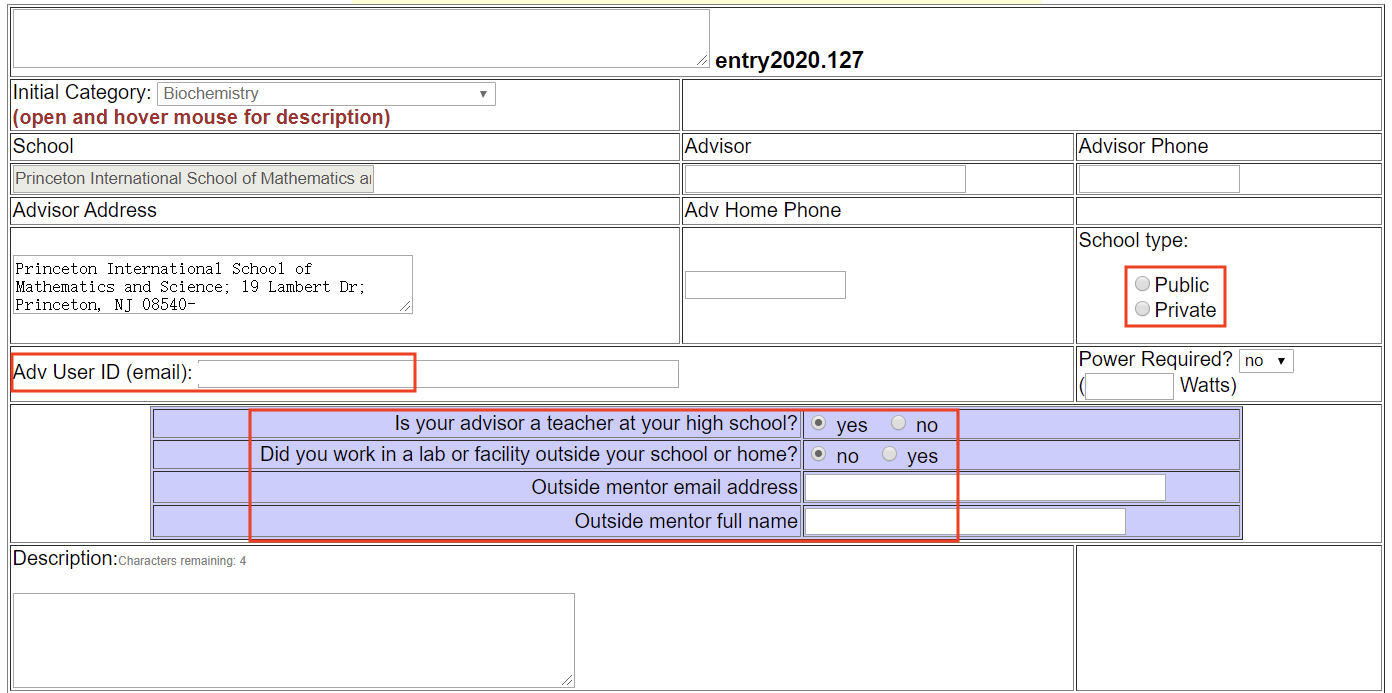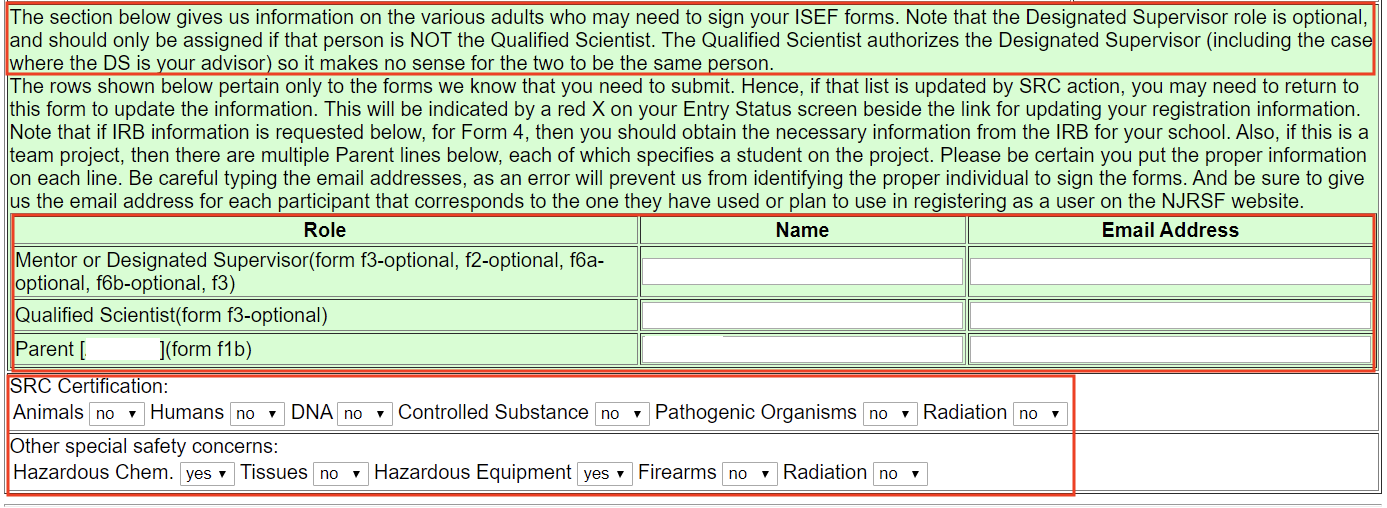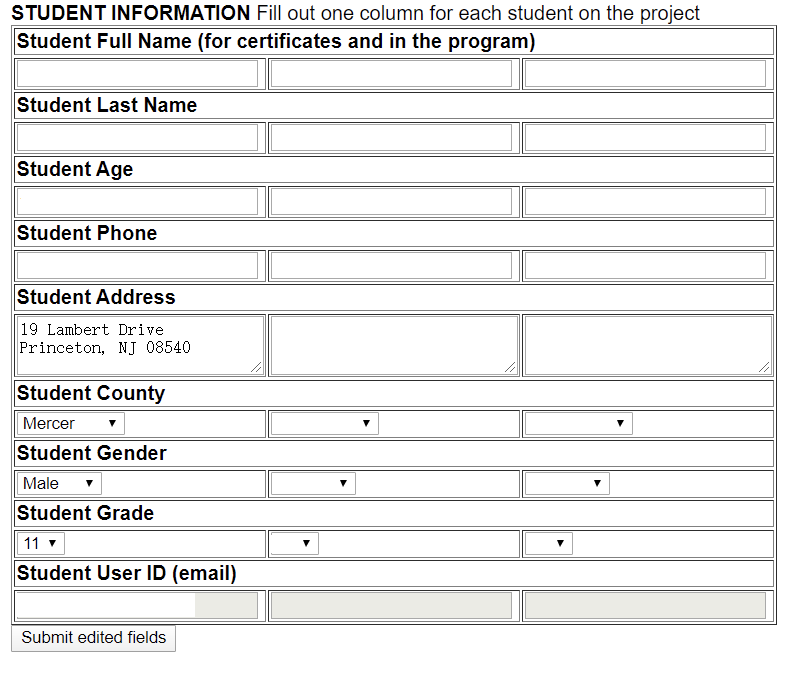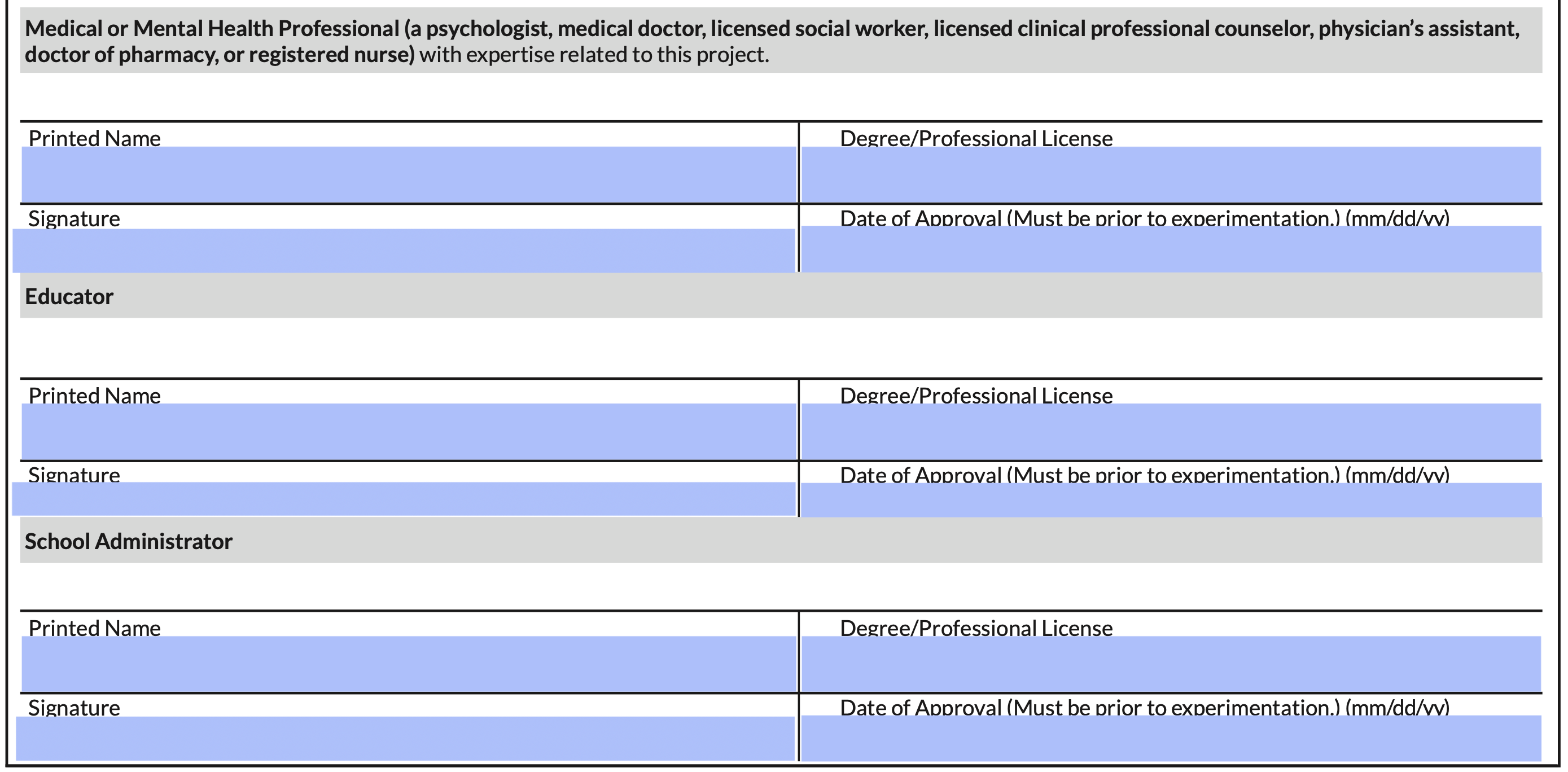drafted by Steven Chen at PRISMS
steven.chen@prismsus.org
Introduction to the Guidance
The information are mainly gathered from the njrsf website here or there, but organized in a way for PRISMS students and mentors to follow easily and know what to do spicifically at each stage.
A Q&A session for some commen questions are also provided in the guidance, please read them before asking questions.
If any conflict is found with the njrsf or ISEF website, please let Dr. Chen know.
Introduction to Science Fair
A science fair is a competitive event, hosted by schools worldwide. The distinguishing characteristic of a science fair is that project entries employ the scientific method to test a hypothesis. Science fairs are not exhibits or mere displays of projects. Students present their science project results in the form of a report, display board, and/or models that they have created.
The mission of the Nokia Bell Labs NJRSF is to support, encourage, and recognize student involvement in scientific research. It is our belief that students can only truly appreciate the creative nature of the scientific process if they have actually experienced it themselves. In addition, we endeavor to provide resources which further this overarching goal, including giving students various opportunities to interact with professional scientists and engineers. The opportunity to partake of the NJRSF itself as well as the other resources we offer is intended to be open to all high school students in the northern NJ region.
In 2019, njrsf sent 6 project including 1 team project to ISEF. In addition to this, 1 alternate and 3 observer positions were also selected for ISEF.
http://njrsf.org/njrsf2019/index.html
Project Registration in NJRSF
The registration of the project at njrsf website is the first and also the most critical step of the whole process. According to the expericience in 2019, most of the problems found later were caused by the incorrect or missing information put here. So the screenshots are attached for students to have a better idea about the information needed.
Part I - Project and advisor information
Please make sure you put the right advisor email address (User ID) in your registration, otherwise your advisor can’t see your entry and sign your form. If your advisor not a teacher in your high school or you have an outside mentor, please make sure you remind them to register an account in the website, acknowledge your registration, and web-sign your forms.
Part II - Adults who may need to sign your form
If you have special types of projects, you need to input the information about qualified scientis/designated supervisor for related forms (form 2, 3, etc.) The qualifed scientist can be your PRISMS mentor if this is the case.
Part III - Personal information
NJRSF and ISEF Forms
ALL PROJECTS need
- Form 1 (Adult Sponsor Checklist)
- Form 1A (Student Checklist)
- Form 1B (Approval Form)
Some projects may need
- Form 1C (Regulated Research Institutional/Industrial Setting Form), when applicable; after completed experiment)
- Form 7 (Continuation/Research Progression Form), when applicable
Certification-based projects need
- Form 4 (Human Participants Form) or appropriate Institutional IRB documentation. Humans, including student designed inventions/prototypes. Requires prior approval by an Institutional Review Board (IRB); see full text of the rules.)
- Sample of Informed Consent Form, when applicable and/or required by the IRB
- Form 2 (Qualified Scientist Form), when applicable and/or required by the IRB
Hazardous Chemicals, Activities and Devices-related projects need (No SRC prior approval required, see full text of the rules.)
- Form 3 (Risk Assessment Form)
- Form 2 (Qualified Scientist Form), required for projects involving DEA-controlled substances or when applicable)
All NJRSF and ISEF forms (availabe in njrsf and ISEF website) are fillable PDF forms that MUST be completed and saved using Adobe Acrobat Reader version 15.0 or higher. You can download and install the software for free from the Adobe website. Note for Mac users: the default PDF Viewer in Safari does not save forms properly and must NOT be used.
- NJRSF Entry Form The NJRSF Entry Form is a simple acknowledgement, by the student and advisor, of your responsibilities as an entrant in our fair along with permission for us to use any photos during the event.
to be web-signed by both the student and advisor
to be web-signed by the adult sponor (either your mentor at PRISMS or your outside mentor)
to be web-signed by student
- NJRSF Research Plan Form (Form 1A Attachment) Note: This is not an ISEF form, but it is provided for interfacing with our electronic registration system. This form is five pages with restricted fields. If you paste text in from another document, make sure that the text fits within the field boundaries or it will be truncated._
- Form 1B: Approval Form This form is required for all students.
to be web-signed by student and parent/guardian__
- Form 1C: Research at a college or research lab Required for any project where the student worked at a research lab or institution under the guidance of a professional scientist or engineer.
to be completed and web-signed by the supervising adult at the research lab or institution;
PRISMS students who used the equipment at IAC@Princeton can just put their PRISMS advisor’s name as the outside mentor, since the staff at IAC only offer the training and don’t guide students’ research.
for special types of projects only.
to be web-signed by the qualified scientist or designatd supervisor.
the qualifed scientists can be your PRISMS mentor, or professers in other labs/institutions based on your where you conduct your research.
for special types of projects with hazardous chemicals only.
to be completed by student in collaboration with qualified scientist/designated supervisor.
to be web-signed by the qualifed scientist/designated supervisor.
for special types of projects with human participants only.
to be completed by student in collaboration with the adult sponsor/designated supervisor/qualified scientist.
to be signed by the student and the__ adult sponsor/designated supervisor/qualified scientist.
The research plan with the risk to the human participants addressed, form 4 signed by student and mentor, written minor assent/written permission/written informed consent (if applicalbe) should be submited to the PRISMS IRB in advance for approval (Ms. D’Angela or Nurse Sheng, Dr.Chen, Mr. Pearce)
- Sample of Informed Consent Form for human subjects
- Form 5: Vertebrate Animals This file include forms 5A (work done at school/home/field) and 5B (work done at Regulated Research Institution). Fill out the one that pertains to your project and leave the other blank.
- Form 6A: Biological Agents Risk Assessment
- Form 6B: Human and Vertebrate Tissues
- Form 7: Project continuation from a prior year
the above three forms are barely applied to research projects at PRISMS.
Overall Schedule - 2020 Fair
December 1, 2019 — Certification deadline.
Certification of all projects that fall under ISEF certification rules. Note that the Form 1C is not required for certification. ISEF forms must be submitted by this date for any project that involves hazardous equipment or materials, vertebrate animals, human subjects, biological microorganisms of any kind, or recombinant DNA. Some schools have been authorized for local SRCs. Please note that there is an EXCEPTION to the local SRC process. We require that projects involving vertebrate animals be approved by the NJRSF SRC (not just the local SRC, if one exists) before the work is begun. If your project falls under this rule, you must request an SRC review, since the existence of your local SRC will prevent it from being triggered automatically.
**
Monday, February 3, 2020 — Entry deadline.
Phase I judging begins. All students involved in individual or team projects must have their projects registered on the website and all NJRSF and ISEF forms submitted electronically by this date. For projects where it is required, a preliminary Form 1C must be submitted if the final is not yet available. Once you have completed the project registration, you should access your Entry Status screen (on the Students dropdown on the navbar) to view instructions for completing your entry, including advisor certification, category certification, electronic form submission, electronic form signatures, and payment of non‑refundable submission fees. Your NJRSF Research Plan Form and Form 1C must be submitted by this date for your project to be included in the Phase I Judging. Entries with incomplete or missing Research Plans and/or Form 1Cs will be automatically withdrawn from the Fair.
Monday, Feb 17, 2020 — Final SRC clearance date.
Phase I judging results announced. Any issues with your submitted ISEF forms must be cleared by this date. If applicable to your project, the final Form 1C must be submitted by this date.
Friday, March 6, 2020 — Abstract and Supplemental Registration submission deadline.
Abstracts are to be submitted electronically. (You must be logged in on the website in order for this process to work properly.) You should submit the text of your abstract in the online form. No other format is accepted. Abstracts are manually reviewed before they are posted on the site, so be sure you make allowance for that delay. Abstracts submitted earlier in the process can be revised until this date.
Friday, March 13 – Saturday, March 14, 2020 — Exhibition Phase of the Fair and Final Judging.
The Fair will be held at Nokia Bell Labs, in Murray Hill (New Providence), NJ. More information can be found on the 2020 Nokia Bell Labs NJRSF information page as it becomes available, such as changes for 2020, the list of projects, the Fair schedule for the Exhibition Phase, and more.
Q&A
Who can register the science fair?
Any PRISMS student with research experience can register the science fair, but not all project are selected to the exhibition stage.
What is the cost of the science fair?
The nonrefundable registration fee is $15/project, which needs to be paid before phase I judge results are to be annouced, but after the njrsf SRC approves the project.
What is the limit of project number per school?
Starting from 2020, each school in the district can only have up to 15 projects to participate in the njrsf. If there are more than 15 projects from PRISMS, Dr. Chen needs to coordinate reserach mentors to select 15.
How to acknowledge students’ registration?
Research mentors will recieve an email sent from the njrsf about the acknowledgement of students’ registration. In order to this, the first step is to register an account as an advsior in the website, then login, go to teachers/advisors -> select projects to enter -> find the project in the drop-down list -> submit choices -> click “Advisor Acknowledgement” in the project status table.
What is web-sign?
Since 2012, njrsf has not required or even encouraged digital signatures. We have replaced this process with a “web-signature” that runs from our website. We encourage all participants to use this new procedure, as it will cut down on work for everybody. The one new requirement this imposes is that you must put in email addresses (a.k.a. user IDs) for each adult who must sign your forms. At a minimum this includes your parents, and for some it will include mentors, IRB members, Designated Supervisor, etc. This requirement is fulfilled after you complete the initial entry, and it is reflected in the first line of your Entry Status block.
How to sign students’ forms on the web?
Once you are logged in, under your name on the navbar, you will see a choice for “sign forms.” Clicking on this will show the forms required and submitted that require your signature (Note that this is keyed to the Roles information on the registration screen if you are not a student or a teacher, so the roles must be updated first.) This screen will enable participants to accomplish the signature process quickly and efficiently, without the hassle of the PDF digital signature process that some of us experienced in 2011. It will especially save time for teachers with a lot of forms to sign.
Who need certification?
Certification of Projects Students with speical types of projects which include Vertebrate Animals, Human Subjects, Recombinant DNA, Microbial Cultures and other Pathogenic Agents, Tissue Samples, Controlled Substances. Supervision of Hazardous Projects There is a class of projects which do not require advance SRC approval, but do require qualified supervision which must be documented.
Why certification is needed?
There are several types of projects for which special regulations apply. These regulations may apply to the work itself, to the exhibit used at the fair, or to both. In all cases, the primary reason for these rules lies in safety, both for the students and for any subjects of their experiments, and for the viewing public. There are often hazards of a hidden nature in scientific work which may not be obvious to the uninitiated student or his/her teacher. These rules are an attempt to educate everybody as to what those hazards are, and to define the circumstances under which certain types of work may be performed and reported. They draw upon the rules for the ISEF competition, but also expanding upon them to provide additional explanation. We do not intend any conflict between what is presented here and the ISEF rules. If any such conflict is perceived, then you may assume that the ISEF rules apply. In all cases where certification of projects is required, the NJRSF makes the additional requirement that the certification paperwork be submitted by Dec. 1 of the year preceding the fair, or before the work is begun, whichever is earlier. The extra deadline of Dec. 1 is set to allow us time for a thorough review of work that falls into these categories, before the students begin any work. Again, our concern here is primarily that of safety.
Which forms are needed for certification?
Besides the forms required by all projects (research plan form, form 1, 1A, 1B), form 2, 3, and 4 may be needed.
Who is your Advisor/Qualified Scientist/Designated Supervisor/Supervising Adult/Outside Mentor, respectively?
Different roles are appreared in different forms. You might have the following different cases:
- For most PRISMS juniors and seniors only work in a research lab at PRISMS, your PRISMS research mentor is your advisor to be put in the registration information.
- If you donot have a research mentor at PRISMS or you work in a college lab or instituation, you should have an outside mentor to be put in the corresponding place in the registration.
- If you have a PRISMS research mentor, but you also work outside, you may need to fill form 1c, which requires the supervising adult to finish and web-sign.
- If you have a special type project, you may need to submit form 2 and get it filled and web-signed by the Qualified Scientist, who can be your PRISMS research mentor if he/she is eligible. If your Qualifed Scientist cannot directly supervise, you need get your form 2 web-signed by the Designated Supervisor.
- If you use hazardous chemicals/equipment, you may need to submit form 3 (risk assessment form) and get it filled and web-signed by the Disignated Supervisor or Qualified Scientist, who can be your PRISMS research mentor.
- If your project involved human participants, you may need to submit form 4, please make sure you put the correct information of the IRB members. The medical or mental health professional is either School Nurse or Ms D’Angela depening on the topic of your project, the educator is Dr. Chen, and the school administrator is Mr. Pearce.

If you case does not apply to any one above, please read the ISEF rules and/or talk to Dr. Chen. If you are not sure about which case works for you, don’t hestitate to contact Dr. Chen.
How long does the certification take?
Students may need to start the registration and related paper work in early Nov. The major work needs to be done include 1) registrater an account in njrsf; 2) register the project njrsf; 3) fill and submit research plan form, form 1, 1A, 1B, and form 2, 3, 4 if applicable; 4) acknowledge the registration by mentor; 5) web-sign forms by student, mentor, and/or parent; 6) submit the research plan with all risks addressed, form 4 (2 and/or 3 if applicable) signed by student and mentor to Dr. Chen for PRISMS IRB to approve; 7) web-sign form 4 by IRB members if approved. 8) wait for the njrsf final SRC clearance All of the above need to be done before Dec 1, and the IRB approval may take 2-3 weeks based on the risks and the information provided.
How to monitor the status of my project?
The overall registration and review process may take up to 2 months, so it is importants for students to monitor the status of their project in the njrsf website. After login, students can go to navibar -> students -> entry status, then a table as attached will be shown for an updated summary about the status. Please check the status/comment if any step is not passed, you may also need to click the SRC Review to read the feedback from the science review committee and revise your registration information/forms/etc. accordingly.

What is Nokia Bell Labs Awards
Nokia Bell Labs will award paid internships for the best projects that help further the Bell Labs mission of innovating for the future needs of humanity. Projects can be about the technical, societal, economic, or environmental aspects of living in an augmented world in which our productivity and capacity for knowledge are greatly increased.
Six finalists will be selected. The six finalists will be required to make a 10-minute presentation on their project to a select group of Nokia Bell Labs judges. The Nokia Bell Labs judges will determine the first place and two second place award winners. All three winners will receive summer internships, which are estimated to last six weeks.
Both team and individual projects are eligible, but candidates must be at least 16 years old. Students selected for exhibition in the first round of judging may apply for the award by submitting a powerpoint presentation in advance of the fair, no later than Mar 6. If your project is selected for the exhibit, the link to upload your presentation will be presented on your Entry Status page after project numbers are assigned.
The internships will run from July 6 to August 14. Students will be expected to be available at least four weeks during this time. http://njrsf.org/njrsf2020/NBLawards.html
Project Display - Exhibition Stage and Final Judge
to be updated

